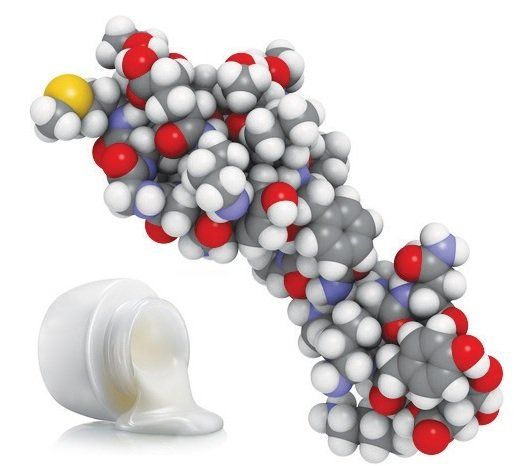Biomimetic Peptides

Biomimetics means mimicking biological activity. Biomimetic peptides are short segments of about 3-6 amino acids, that mimic natural biological activities that occur in the skin. Why should we mimic the skin’s natural activities?
Well, there are signals in the skin we are interested in mimicking and causing them to happen artificially. For example, the signal that results in the production of new collagen, hyaluronic acid, and additional skin proteins responsible for firm skin; the signal resulting in moderating the secretion or the effect of inflammation factors; the signal leading to the cessation of acetylcholine secretion from the nerve endings, which leads to disrupted muscle contraction on the sides of the eyes or the forehead (the Botox effect). These various signals are an integral part of the skin’s life, and happen under the influence of signal molecules that are secreted in it. Let’s take a look at an example of signals associated with the skin’s firmness.
As we age, the skin produces less collagen, hyaluronic acid, and proteoglycans (which maintain the skin’s high water content). As a result, the skin loses some of its firmness, elasticity, thickness, and water content. It becomes thinner, saggy, dry, and with a higher tendency to develop wrinkles. All of these changes happen in the dermis – the thick middle layer that is responsible for most of the skin’s aging processes. The main dermis cells are called fibroblasts, and they produce the collagen, elastin, hyaluronic acid, and in fact all of the extracellular matter (the ECM). With age, they work more slowly and less effectively. Can we stimulate them and encourage them to produce these important skin components?
What are peptides?
A peptide is a short sequence of amino acids. Amino acids are the building blocks of proteins. A protein is comprised of tens to hundreds of amino acids. A peptide contains up to 50 amino acids. Peptides in the body function as messengers, as hormones (which are also messengers) and they signal to the cells to perform an action
Cosmetic biomimetic peptides
The peptides that are designed to renew the skin induce the production of collagen, hyaluronic acid and proteoglycans (A main and important component in maintaining skin moisture). They firm the skin, delay the formation of wrinkles, and improve the appearance of fine lines.
Some peptides were designed to mimic the Botox effect – to prevent the release of acetylcholine into the synapse between the nerve and the muscle, thus helping to minimize expression lines. Two representatives from this family are Argireline (on the package: Acetyl hexapeptide) and SNAP-8.
Another peptide from the firming family is Chronoline, and it works on the dermal-epidermal junction. The contact between the epidermis and the dermis is characterized by a wavy structure. With age, the number of waves (rete pegs, or ridges) and their depth decreases and the structure becomes flatter. This reduces the contact area between the epidermis and the dermis, and minimizes the supply of oxygen and nutrients, the ability to clear waste to the bloodstream, to effectively treat infections, and also decreases the skin’s mechanical strength. One of the reasons for the flattening of the rete fidges is a decrease in the quantity and quality of proteins that characterize this junction, among them collagen type 7, collagen type 4 and others. The peptide ChroNOline boosts the production of two special proteins (one of them is collagen-7) responsible for the tight contact between the dermis and the epidermis.
Additional biominetic peptides are designed to sooth irritated skin, treat acne, treat hyperpigmentation, Compensation for the decrease in the secretion of estrogenic hormones during menopause and postmenopause..
